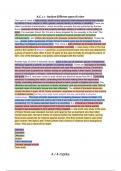A.C. 1.1 - Analyse different types of crime
One type of crime is hate crimes, which is any behaviour that someone thinks was caused
by hatred of race, religion or faith, gender, sexual identity or identity or disability. These are
called ‘protected characteristics’, which minorities possess that are protected by the law.
Some examples of hate crime are property damage, attacks of violence, name calling, or
arson. For example, David, Mr. S’s son is being targeted for his sexuality in the brief. The
offenders are anybody who has hatred or prejudice towards people with ‘protected
characteristics’, and victims are anyone who possess ‘protected characteristics’. There has
been greater public awareness of hate crimes in recent years due to increased focus on
reporting, investigating and prosecution. This crime is both criminal, as it breaks the law, and
deviant as the behaviour is not socially acceptable normality. A case study of this in the real
world is the murder of Stephen Lawrence, a young innocent black man who was attacked by
a group of racist in April 1993. It took 15 years for the case to finally be brought to justice. In
2011, two of the teenagers, now adults, were charged with the murder.
Another type of crime is domestic abuse, which is the use of violence, abuse or threatening
behaviour against a partner, ex-partner or a family member. There are five types of domestic
abuse. Physical, physical and sexual assaults and rape like punches, kicking. Financial is
the control over a partners or victims' money or collecting debts in their name. Emotional
abuse is intimidation or threats, undermining and criticizing them or manipulating them to
feel guilty. Mrs S. has been victim to both verbal and physical abuse from Mr S. Controlling
behaviour is isolating the victim, controlling their life and making them feel dependent.
Finally, controlling behaviour is emotional abuse to harm, punish or frighten the victim. The
offenders are partners, ex-partners or family members, and are predominantly male. 99% of
reported cases of domestic abuse are male offenders. The victims of domestic abuse are
usually females in ages 16-24, family members, separated or divorced women or low income
or disbaled women as they may need more support and are vulnerable to abusive
relationships. The level of public awareness is increasing however, abuse is hidden. It is
extremely under-reported and victims don’t feel it will make much of a difference to report it,
considering 1 in 12 cases reported result in a conviction. It is criminal as it breaks the law,
however some cultures and religions find it deviant while others do not. Some women
thought it was acceptable to hit a partner if they cheated. A real world case study is the case
of Claire Woods was strangled, burned, and raped by her ex-boyfriend who then killed
himself days later. He had a history of violence before his relationship with Claire, serving
three prison sentences for violence against women. This then evoked Claire’s Law which
gave women “the right to ask” if their partner had a history of violence and a background
check. This was a result of her death.
Definition
Examples
Offenders
Victims
Public awareness
Criminal, deviant or both
Case study
marks




